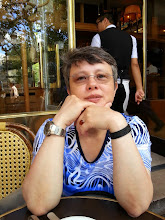"Night Windows", 1928, Edward Hopper, Oil on Canvas, 73.7 x 86.4 cm, MoMa, New York
"You are nothing, but a voyeur..." First, there are the silences. Those moments where nothing and nobody will be able to reach you. You put the Do Not Disturb sign on your door handle. You want her all for yourself, don't you? It is almost as if she knew, someone would inevitably book the shabby room under the rooftop, just to have a peek at her. What else is there to do, anyway? Looking at her, this woman in her pink chemise, almost offering her body to male gaze. Perhaps the end of boredom? Anything to get away from the easel, the brushes, the sketchbook, the relentless question. "What are you working on, now?". Better not to answer, at all. Better to remain silent. What do these art critics really understand, about your painting? They talk about Hopper's silence, but they keep asking you to expand on it! You: "Everything is there, in my painting". Them: "Quite right, Mr Hopper, but what can you tell us about it?". What can one say about it, about life? Alone, or surrounded with people, it does not make any difference. In the end, you are alone. Jo understands that, or at least, she gave up fighting with your silence(s). It is no use. Words are deceiving. In a minute, someone will say or do something and spoil everything. They look, but they do not see.
"Night Windows", 1928. Hopper (1882-1967) likes this painting. Jo, too. At first, she was reticent, as she always is when you indulge your voyeuristic penchant. "You are nothing, but a voyeur...", she said. Am I, really? And what, if I am? When Edward Hopper painted "Night Windows" in 1928, only five years after his breakthrough: "The Mansard Roof", at the Brookyn Museum since 1923, he wanted to try something new. Really? What Jo saw, what everybody saw, at first, was another scantily clad woman, alone in her hotel room - but, is she really? - bending over something, no one will ever see. The idea for this painting came after yet another pointless argument with Jo. You caught her writing in her diary, and stupidly asked what about. Why does one ever ask such a question? She said, she is tired of posing for you, only to end up on the canvas, as an anonymous bottom. You said, what's wrong with that? Bottom line? You are a posterior-centric person. How can you make her see what you see, beyond your obvious fascination with female derriere? What is there to see, anyway?

In "Night Windows", what you see is not what you get. Hopper's penchant for female bottom is transformed into some kind of visual pun. First, there are the silences. Then, the loneliness, and almost immediately after it, the emptiness. Peering at a shapely woman in her nightie, unaware of your presence, is just an excuse. It is difficult to convey in painting, what your inner world looks like. How can "Night Windows" be labelled a voyeuristic painting? The light is too bright. The window frame on the right-hand side is curtained, and her body is too hidden to feed your fantasy, the way you like it. What then? The canvas? The lines? The colour linkages? Hopper's visual language is not really there to communicate with us - the onlookers - nor does it try to share something with us. Hopper is and remains an individualist, at heart. "I don't think I ever tried to paint the American scene, I'm trying to paint myself", you once said to an art critic. Is "Night Windows", another selfish visual statement? Besides the visual spun - the rounded corner of the painted building that reiterates the rounded body of the woman - "Night Windows", is not only about intimacy spied upon. It is about the human condition. The bare essentials: in painting and in life.
Although, a recurrent pictorial device, the rückenfigur, has been used for many different purposes. Caspar David Friedrich (1774-1840), for instance, used it to tell us something about our relation to nature, to the divine. His rückenfigur is here to communicate, to make us feel what lies beyond the simple act of looking. Hopper's rückenfigur, like his windows, are not about hope or revelation. They seem to exist only to witness the empty hauntedness of our condition. They are not narratives, they are memento mori. Remember death. And before it happens, there is the long awaited fulfilment that will never happen. Me, a voyeur? Jo got it all wrong. But, I do like windows. I like what they remind me of: the inescapable silence, within and around us. They have a poetic dimension, too. They are the speechless midpoint of our existence. Of course, they are also, passageways, thresholds. But to what, exactly? I am not sure. Perhaps, to the end of boredom, resignation, melancholy? But, I do not believe in the after. I am here and now. Hopper, the painter. Stuck with the everlasting now. Am I a voyeur? I confess, I like a bit of emotional espionage. New York is so beautiful, in summer. I went back to this hotel, with its shabby room, underneath the rooftop. Waited a long time, in the dark, sweating in the sultry air, just to get a glimpse at her. Beautiful, and beyond my reach. She simply does not care about me, about being seen in her nightie. Does she know, I am a painter?



























